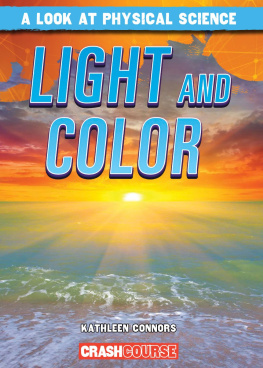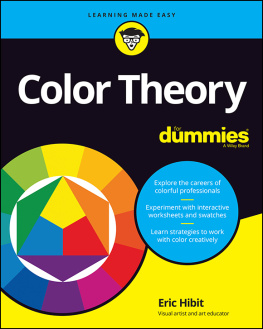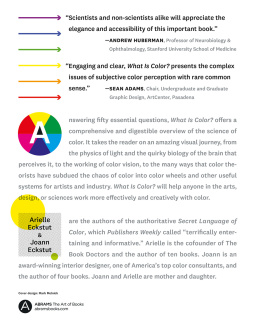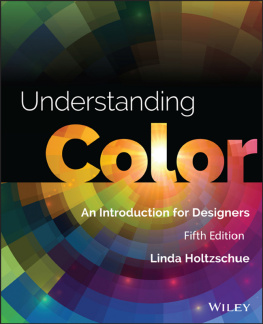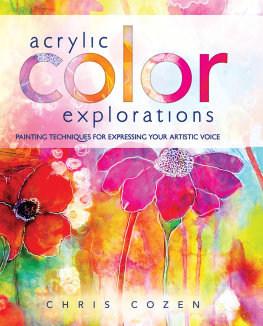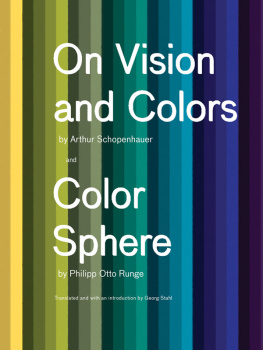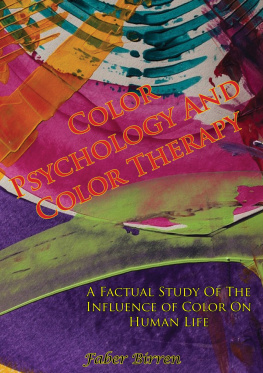Table of Contents
This book was originally published in Germany under the title Kunst der Farbe copyright 1961 and 1973 by Otto Major Verlag Ravensburg, Germany
Printed in Germany
Color separation: Seiler & Jelile, Augsburg
Composition: Buch-und Verlagsdruckerei Gppel, Ravensburg
Printing: Appl, Wemding
This book is printed on acid-free paper.

Published in the United States of America by John Wiley & Sons, Inc.
Published simultaneously in Canada.
No part of this publication may be reproduced, stored in a retrieval system or transmitted in any form or by any means, electronic, mechanical, photocopying, recording, scanning or otherwise, except as permitted under Sections 107 or 108 of the 1976 United States Copyright Act, without either the prior written permission of the Publisher, or authorization through payment of the appropriate per-copy fee to the Copyright Clearance Center, 222 Rosewood Drive, Danvers, MA 01923, (978) 750- 8400, fax (978) 750-4744. Requests to the Publisher for permission should be addressed to the Permissions Department, John Wiley & Sons, Inc., 605 Third Avenue, New York, NY 10158-0012, (212) 850-6011, fax (212) 850-6008, E-Mail:
PERMREQ@WILEY.COM.
This publication is designed to provide accurate and authoritative information in regard to the subject matter covered. It is sold with the understanding that the publisher is not engaged in rendering professional services. If professional advice or other expert assistance is required, the services of a competent professional person should be sought.
Library of Congress Cataloging-in-Publication Data:
Library of Congress Catalog Card Number 61-11190
ISBN 0-471-28928-0
12 11 10 9 8 7 6 5 4
THIS BOOK IS DEDICATED TO MY STUDENTS
ACKNOWLEDGMENT
When the plans for this book were at the stage of discussion between Mr. Peter Maier and myself, he already fully appreciated the technical difficulties involved in so ambitious an undertaking. As a result of his courageous decision, the publishers have worked indefatigably to make my experience of color available to a larger audience beyond the classroom. I am grateful to the publishing house of Otto Maier for their faith in my project and for their splendid cooperation. Members of the staff were consistently helpful in dealing skillfully with the many problems that arose.
The Graphische Anstalt E. Wartelsteiner, of Munich, has devoted the most painstaking attention to color fidelity in the reproduction of the illustrations.)
Mrs. Lucia Moholy has been of valuable aid to me in the editing of the manuscript.
This book could never have been completed without the unfailing assistance and encouragement of my wife.
Zurich, February 18, 1961.
Johannes Itten.
To the new 1973 edition
When preparing the first edition of The Art of Color in 1960, author and publisher faced the difficult problem of finding the best way of reproducing the color. This could only be achieved by producing the various color illustrations and tables in different printing processes done by several printers - partly with special colors - and tipping them in the book.
In 1970, when the students edition was planned, this complicated method of production could not be retained. Thanks to advanced technology, the printing quality of the students edition was in many ways an improvement over the large edition. Thus, a standard was set for a new large edition. For the present new printing, the entire production was adapted for offset.
The reproduction of all the illustrations was done by Seiler & Jehle, Augsburg, without whose valuable collaboration the book could not have appeared in its present form. We gratefully acknowledge here this accomplishment, as well as the excellent printing by J. Fink, Stuttgart-Kemnat.
All together, care was taken to leave the work untouched. Contents and sequence of pages have been retained, some of the illustrations enlarged and improved according to existing copies. The aim of the new edition is to make Johannes Ittens color theory available again, improved and strictly adhering to his principles of presentation.
Zurich, April 1973
Anneliese Itten
INTRODUCTION
Learning from books and teachers is like traveling by carriage, so we are told in the Veda. The thought goes on, But the carriage will serve only while one is on the highroad. He who reaches the end of the highroad will leave the carriage and walk afoot.
In this book I shall try to build a serviceable conveyance that will help all who are interested in the problems of color artistry. One may travel carriage-less and by unblazed trails, but progress is then slow and the journey perilous. If a high and distant goal is to be attained, then it is advisable to take a carriage at first in order to advance swiftly and safely.
Many of my students have helped me to find materials with which to build, and I am deeply indebted to them. The doctrine to be developed here is an aesthetic color theory originating in the experience and intuition of a painter. For the artist, effects are decisive, rather than agents as studied by physics and chemistry. Because color effects are in the eye of the beholder, the many color plates were indispensable. Yet the deepest and truest secrets of color effect are, I know, invisible even to the eye, and are beheld by the heart alone. The essential eludes conceptual formulation.
In the realm of aesthetics, are there general rules and laws of color for the artist, or is the aesthetic appreciation of colors governed solely by subjective opinion? Students often ask this question, and my answer is always the same: If you, unknowing, are able to create masterpieces in color, then un-knowledge is your way. But if you are unable to create masterpieces in color out of your un-knowledge, then you ought to look for knowledge.
Doctrines and theories are best for weaker moments. In moments of strength, problems are solved intuitively, as if of themselves.
Close study of the great master colorists has firmly convinced me that all of them possessed a science of color. For me, the theories of Goethe, Runge, Bezold, Chevreul and Hlzel have been invaluable.
I hope to be able to resolve a great many color problems in this book. We are not merely to expound objective principles and rules, but also to explore and survey the subjective predicament, as it pertains to critical taste in the realm of color.
We can be released from subjective bondage only through knowledge and awareness of objective principles.
In music, the theory of composition has long been an important and accepted part of a professional education. However, a musician may know counterpoint and still be a dull composer, if he lacks insight and inspiration. Just so, a painter may know all the resources of composition in form and color, yet remain sterile if inspiration be denied him.
It has been said that genius is 99 percent perspiration and 1 percent inspiration. There was a debate in the press years ago between Richard Strauss and Hans Pfitzner about the relative shares of inspiration and contrapuntal deduction in the process of composition. Strauss wrote that four to six bars were inspiration in his own works, and the rest elaboration. Pfitzner replied, It may well be that Strauss is inspired only through four to six bars, but I have noticed that Mozart often composes many pages together under inspiration.


